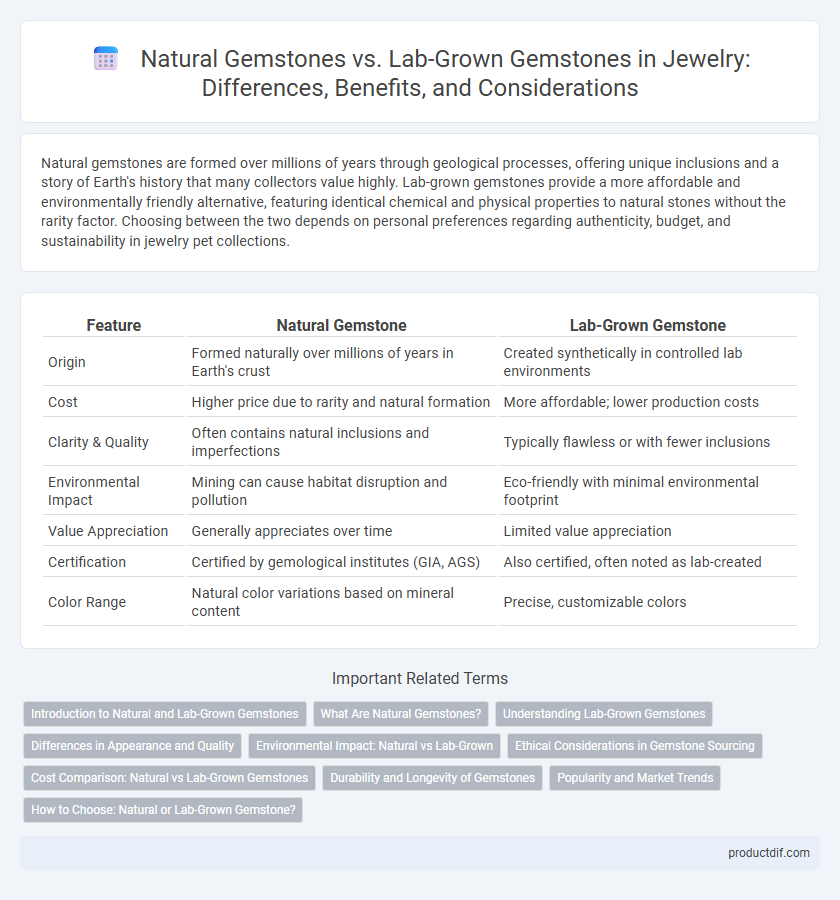Natural gemstones are formed over millions of years through geological processes, offering unique inclusions and a story of Earth's history that many collectors value highly. Lab-grown gemstones provide a more affordable and environmentally friendly alternative, featuring identical chemical and physical properties to natural stones without the rarity factor. Choosing between the two depends on personal preferences regarding authenticity, budget, and sustainability in jewelry pet collections.
Table of Comparison
| Feature | Natural Gemstone | Lab-Grown Gemstone |
|---|---|---|
| Origin | Formed naturally over millions of years in Earth's crust | Created synthetically in controlled lab environments |
| Cost | Higher price due to rarity and natural formation | More affordable; lower production costs |
| Clarity & Quality | Often contains natural inclusions and imperfections | Typically flawless or with fewer inclusions |
| Environmental Impact | Mining can cause habitat disruption and pollution | Eco-friendly with minimal environmental footprint |
| Value Appreciation | Generally appreciates over time | Limited value appreciation |
| Certification | Certified by gemological institutes (GIA, AGS) | Also certified, often noted as lab-created |
| Color Range | Natural color variations based on mineral content | Precise, customizable colors |
Introduction to Natural and Lab-Grown Gemstones
Natural gemstones form over millions of years through geological processes, resulting in unique chemical compositions and physical properties that make each stone distinct. Lab-grown gemstones are created under controlled conditions that mimic nature, offering the same durability and optical characteristics but with greater ethical and environmental transparency. Both types of gemstones provide exquisite options for jewelry, but natural stones often carry higher value due to rarity, while lab-grown gems appeal for affordability and sustainability.
What Are Natural Gemstones?
Natural gemstones are precious or semi-precious minerals formed over millions of years through geological processes deep within the Earth's crust. These stones, such as diamonds, sapphires, rubies, and emeralds, are valued for their unique chemical composition, natural inclusions, and rarity. Their authenticity and origin significantly impact their market value and appeal in fine jewelry.
Understanding Lab-Grown Gemstones
Lab-grown gemstones are created through controlled technological processes that replicate the natural formation of minerals, resulting in gems chemically and physically identical to natural stones. These synthetic gems offer consistent quality, fewer inclusions, and a more sustainable and ethical choice compared to mined counterparts. Advances in hydrothermal and flux-growth methods have enabled the production of a wide variety of lab-grown gemstones, including diamonds, sapphires, and emeralds.
Differences in Appearance and Quality
Natural gemstones exhibit unique inclusions and color variations caused by geological processes over millions of years, offering unparalleled individuality and depth. Lab-grown gemstones are crafted with controlled conditions, producing flawless clarity and consistent color, often indistinguishable from natural stones to the naked eye. Quality differences emerge mainly in rarity and origin authenticity, with natural stones valued for their natural formation and lab-grown gems prized for ethical sourcing and affordability.
Environmental Impact: Natural vs Lab-Grown
Natural gemstones require extensive mining that disrupts ecosystems, depletes natural resources, and generates significant carbon emissions. Lab-grown gemstones offer a more sustainable alternative by minimizing land disturbance and reducing energy consumption through controlled, repeatable production processes. Choosing lab-grown gems supports reduced environmental impact while maintaining the beauty and quality of traditional natural stones.
Ethical Considerations in Gemstone Sourcing
Natural gemstones often raise ethical concerns due to mining practices linked to environmental degradation and labor exploitation. Lab-grown gemstones provide a sustainable alternative, offering identical physical and chemical properties without the negative social and ecological impact. Ethical sourcing standards increasingly favor lab-grown options as consumers prioritize transparency and responsible supply chains in the jewelry industry.
Cost Comparison: Natural vs Lab-Grown Gemstones
Natural gemstones typically have a higher price due to their rarity, unique inclusions, and the extensive mining process required. Lab-grown gemstones offer a more budget-friendly option, often costing 30-70% less while maintaining the same physical, chemical, and optical properties. Consumers seeking affordability without sacrificing quality frequently choose lab-grown stones for rings, earrings, and other fine jewelry pieces.
Durability and Longevity of Gemstones
Natural gemstones typically exhibit greater durability and longevity due to their formation under extreme geological conditions over millions of years, resulting in stable crystal structures resistant to wear and damage. Lab-grown gemstones, while often chemically identical and visually flawless, can sometimes have inclusions or structural weaknesses introduced during the manufacturing process, which may affect their long-term resilience. Both types benefit from proper care, but natural gemstones generally maintain their structural integrity and brilliance longer under everyday wear.
Popularity and Market Trends
Natural gemstones maintain strong popularity due to their unique origin and rarity, driving high demand in luxury markets and collector circles. Lab-grown gemstones rapidly gain market share, valued for their ethical production, affordability, and consistent quality, appealing to environmentally conscious consumers. Market trends indicate growing acceptance of lab-created gems, with projected annual growth rates exceeding 20% in the colored gemstone sector.
How to Choose: Natural or Lab-Grown Gemstone?
Choosing between natural and lab-grown gemstones depends on factors such as budget, sustainability preferences, and desired gemstone quality. Natural gemstones offer unique inclusions and rarity, while lab-grown gemstones provide eco-friendly alternatives with consistent clarity and color at a lower cost. Evaluate the gemstone's origin certification, durability, and your ethical values to make an informed decision.
Natural Gemstone vs Lab-Grown Gemstone Infographic

 productdif.com
productdif.com